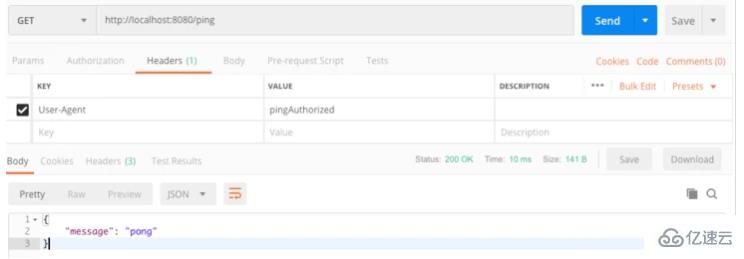您好,登錄后才能下訂單哦!
您好,登錄后才能下訂單哦!
這篇文章主要講解了“golang iris的使用方法”,文中的講解內容簡單清晰,易于學習與理解,下面請大家跟著小編的思路慢慢深入,一起來研究和學習“golang iris的使用方法”吧!
go get github.com/kataras/iris
app := iris.New()
app.Handle("GET", "/ping", func(ctx iris.Context) {
ctx.JSON(iris.Map{"message": "pong"})
})
app.Run(iris.Addr(":8080"))幾行代碼就可以實現,通過瀏覽器訪問http://localhost:8080/ping會返回{"message":"pong"}
使用Handle函數可以注冊方法,路徑和對應的處理函數
如果我們希望記錄下所有的請求的log信息還希望在調用相應的route時確認請求的UA是否是我們允許的可以通過Use函數添加相應的middleware
package main
import (
"github.com/kataras/iris"
"github.com/kataras/iris/middleware/logger"
)
func main() {
app := iris.New()
app.Use(logger.New())
app.Use(checkAgentMiddleware)
app.Handle("GET", "/ping", func(ctx iris.Context) {
ctx.JSON(iris.Map{"message": "pong"})
})
app.Run(iris.Addr(":8080"))
}
func checkAgentMiddleware(ctx iris.Context) {
ctx.Application().Logger().Infof("Runs before %s", ctx.Path())
user_agent := ctx.GetHeader("User-Agent")
if user_agent != "pingAuthorized" {
ctx.JSON("No authorized for ping")
return
}
ctx.Next()
}
使用postman訪問在Header中添加User-Agent訪問/ping可以正常返回結果,如果去掉User-Agent則會返回我們設定的"No authorized for ping"。因為我們添加了iris的log middleware所以在訪問時會在終端顯示相應的log信息
bookinfo.html
<html>
<head>Book information</head>
<body>
<h3>{{ .bookName }}</h3>
<h2>{{ .bookID }}</h2>
<h2>{{ .author }}</h2>
<h2>{{ .chapterCount }}</h2>
</body>
</html>main.go
package main
import "github.com/kataras/iris"
func main() {
app := iris.New()
app.RegisterView(iris.HTML("./views", ".html"))
app.Handle("GET", "/bookinfo/{bookid:string}", func(ctx iris.Context) {
bookID := ctx.Params().GetString("bookid")
ctx.ViewData("bookName", "Master iris")
ctx.ViewData("bookID", bookID)
ctx.ViewData("author", "Iris expert")
ctx.ViewData("chapterCount", "40")
ctx.View("bookinfo.html")
})
app.Run(iris.Addr(":8080"))
}取得請求中帶的參數
ctx.Params().GetString("bookid")設置html中變量的值
ctx.ViewData(key, value)
route允許和禁止外部訪問
實際使用中有時會有些route只能內部使用,對外訪問不到。
可以通過使用 XXX_route.Method = iris.MethodNone設定為offline
內部調用通過使用函數 Context.Exec("NONE", "/XXX_yourroute")
main.go
package main
import "github.com/kataras/iris"
import "strings"
func main() {
app := iris.New()
magicAPI := app.Handle("NONE", "/magicapi", func(ctx iris.Context) {
if ctx.GetCurrentRoute().IsOnline() {
ctx.Writef("I'm back!")
} else {
ctx.Writef("I'll be back")
}
})
app.Handle("GET", "/onoffhandler/{method:string}/{state:string}", func(ctx iris.Context) {
changeMethod := ctx.Params().GetString("method")
state := ctx.Params().GetString("state")
if changeMethod == "" || state == "" {
return
}
if strings.Index(magicAPI.Path, changeMethod) == 1 {
settingState := strings.ToLower(state)
if settingState == "on" || settingState == "off" {
if strings.ToLower(state) == "on" && !magicAPI.IsOnline() {
magicAPI.Method = iris.MethodGet
} else if strings.ToLower(state) == "off" && magicAPI.IsOnline() {
magicAPI.Method = iris.MethodNone
}
app.RefreshRouter()
ctx.Writef("\n Changed magicapi to %s\n", state)
} else {
ctx.Writef("\n Setting state incorrect(\"on\" or \"off\") \n")
}
}
})
app.Handle("GET", "/execmagicapi", func(ctx iris.Context) {
ctx.Values().Set("from", "/execmagicapi")
if !magicAPI.IsOnline() {
ctx.Exec("NONE", "/magicapi")
} else {
ctx.Exec("GET", "/magicapi")
}
})
app.Run(iris.Addr(":8080"))
}測試:
<1>訪問http://localhost:8080/magicapi,返回Not found。說明route magicapi對外無法訪問
<2>訪問http://localhost:8080/execmagicapi,返回I'll be back。在execmagicapi處理函數中會執行 ctx.Exec("GET", "/magicapi")調用offline的route magicapi。在magicapi中會判斷自己是否offline,如果為offline則返回I'll be back。
<3>訪問http://localhost:8080/onoffhandler/magicapi/on改變magicapi為online
<4>再次訪問http://localhost:8080/magicapi,返回I'm back!。說明route /mabicapi已經可以對外訪問了grouping route
在實際應用中會根據實際功能進行route的分類,例如users,books,community等。
/users/getuserdetail /users/getusercharges /users/getuserhistory /books/bookinfo /books/chapterlist
對于這類route可以把他們劃分在users的group和books的group。對該group會有共通的handler處理共同的一些處理
package main
import (
"time"
"github.com/kataras/iris"
"github.com/kataras/iris/middleware/basicauth"
)
func bookInfoHandler(ctx iris.Context) {
ctx.HTML("<h2>Calling bookInfoHandler </h2>")
ctx.HTML("<br/>bookID:" + ctx.Params().Get("bookID"))
ctx.Next()
}
func chapterListHandler(ctx iris.Context) {
ctx.HTML("<h2>Calling chapterListHandler </h2>")
ctx.HTML("<br/>bookID:" + ctx.Params().Get("bookID"))
ctx.Next()
}
func main() {
app := iris.New()
authConfig := basicauth.Config{
Users: map[string]string{"bookuser": "testabc123"},
Realm: "Authorization required",
Expires: time.Duration(30) * time.Minute,
}
authentication := basicauth.New(authConfig)
books := app.Party("/books", authentication)
books.Get("/{bookID:string}/bookinfo", bookInfoHandler)
books.Get("/chapterlist/{bookID:string}", chapterListHandler)
app.Run(iris.Addr(":8080"))
}上例中使用了basicauth。對所有訪問books group的routes都會先做auth認證。認證方式是username和password。
在postman中訪問 http://localhost:8080/books/sfsg3234/bookinfo
設定Authorization為Basic Auth,Username和Password設定為程序中的值,訪問會正確回復。否則會回復Unauthorized
感謝各位的閱讀,以上就是“golang iris的使用方法”的內容了,經過本文的學習后,相信大家對golang iris的使用方法這一問題有了更深刻的體會,具體使用情況還需要大家實踐驗證。這里是億速云,小編將為大家推送更多相關知識點的文章,歡迎關注!
免責聲明:本站發布的內容(圖片、視頻和文字)以原創、轉載和分享為主,文章觀點不代表本網站立場,如果涉及侵權請聯系站長郵箱:is@yisu.com進行舉報,并提供相關證據,一經查實,將立刻刪除涉嫌侵權內容。